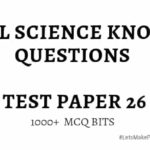NCERT MCQ Bits
General Science MCQ Questions For Competitive exams
Test Paper 19
Learn General science questions for competitive exams NCERT MCQ Questions
1. Breakdown of food in cells with energy release is called as ?
Gtheos 2.4GHz Wireless Gaming Headset – White
a) Cells breakdown
b) Food breakdown
c) Cellular respiration
d) None
c) Cellular respiration
2. In cell, glucose breaks down to which of the following components using oxygen ?
a) Carbon dioxide
b) Water
c) Both
d) None
c) Both
3. Breakdown of glucose using oxygen is called as ?
a) Anaerobic Respiration
b) Aerobic Respiration
c) Both
d) None
b) Aerobic Respiration
3. Breakdown of glucose without use of oxygen is called as ?
a) Anaerobic Respiration
b) Aerobic Respiration
c) Both
d) None
a) Anaerobic Respiration
4. Which of the following organism can survives without oxygen ?
a) Yeast
b) Bacteria
c) Both
d) None
a) Yeast
5. Glucose breakdown into which of the following products in the absence of oxygen ?
a) Alcohol and CO2
b) CO2 and water
c) Alcohol and CO
d) None
a) Alcohol and CO2
6. Cells in human body can respire anaerobic ?
a) Yes
b) No
a) Yes
Note: Yes, But only for short time as if deficiency in oxygen
7. In muscles, Glucose breakdown into which of the following component in absence of oxygen ?
a) CO2
b) Lactic acid
c) Both
d) None
b) Lactic acid
8. Cramps in muscles occurs when muscle cell respire ?
a) Anaerobic Respiration
b) Aerobic Respiration
c) Both
d) None
a) Anaerobic Respiration
9. Which of following acid accumulation causes cramps in muscle ?
a) Hydrochroric acid
b) Lactic acid
c) Both
d) None
b) Lactic acid
10. Partial breakdown of Glucose releases ?
a) Hydrochroric acid
b) Lactic acid
c) Both
d) None
b) Lactic acid
11. Humans inhalation and exhalation ?
a) Oxygen and Carbon dioxide
b) Carbon dioxide and oxygen
c) Both
d ) None
a) Oxygen and Carbon dioxide
12. On Average, adult humans breathing rate ?
a) 15- 50 times in min
b) 25- 35 times in min
c) 35- 50 times in min
d) 15- 18 times in min
d) 15- 18 times in min
13. During inhalations, Ribs moves _____ and diaphragm moves ___ ?
a) Down and Down
b) Up- Outwards and Down
c) Up-outwards and Up
d) None
b) Up- Outwards and Down
14. Humans inhales air ?
a) 50% Oxygen and 10% Carbon dioxide
b) 80% Oxygen and 10% Carbon dioxide
c) 90% Oxygen and 10% Carbon dioxide
d) 21% Oxygen and 0.04% Carbon dioxide
d) 21% Oxygen and 0.04% Carbon dioxide
15. Humans exhales air ?
a) 16.4% Oxygen and 4.4% Carbon dioxide
b) 20% Oxygen and 10% Carbon dioxide
c) 16.4% Oxygen and 30% Carbon dioxide
d) 21% Oxygen and 0.04% Carbon dioxide
a) 16.4% Oxygen and 4.4% Carbon dioxide
16. Earthworm breathes through ?
a) Skin
b) Body
c) Lungs
d) None
a) Skin
17. Cockroach breathes through
a) Skin
b) Tracheae
c) Lungs
d) None
b) Tracheae
18. Fish breathes through
a) Skin
b) Tracheae
c) Lungs
d) Gills
d) Gills
19. For Humans, Breathing of pure oxygen for long time is ?
a) Safe
b) Unsafe
c) Both
d) None
b) Unsafe
20. Fluid part of blood is called ?
a) Blood liquid
b) Plasma
c) Hemoglobin
d) None
b) Plasma
21. Blood is in red colour because of ?
a) Red Blood liquid
b) Red Plasma
c) Hemoglobin
d) None
c) Hemoglobin
22. Which of the following helps in transportation of oxygen to all cells in the body ?
a) Lungs
b) Red Plasma
c) Hemoglobin
d) None
c) Hemoglobin
23. Which of following fights against germs in our body ?
a) RBC
b) WBC
c) Both
d) None
b) WBC
24. Types of Blood Vessels?
a) Arteries and Veins
b) Arteries and Platelets
c) Platelets and Veins
d) None
a) Arteries and Veins
25. Arteries carries _______ rich blood ?
a) Carbon dioxide
b) Oxygen
c) Both
d) None
b) Oxygen
26. Arteries carry blood from ?
a) All parts to Heart
b) Hearts to all parts
c) Both
d) None
b) Hearts to all parts
27. Veins carries _______ rich blood ?
a) Carbon dioxide
b) Oxygen
c) Both
d) None
a) Carbon dioxide
28. Veins carry blood from ?
a) All parts to Heart
b) Hearts to all parts
c) Lungs
d) None
a) All parts to Heart
29. Arteries has _______ walls ?
a) Thin walls
b) Thick walls
c) Thick elastic walls
d) None
c) Thick elastic walls
30. Veins has _______ walls ?
a) Thin walls
b) Thick walls
c) Thick elastic walls
d) None
a) Thin walls
31. Human hearts has ____ chambers ?
a) 5 chambers
b) 3 chambers
c) 4 chambers
d) 2 chambers
c) 4 chambers
32. Cockroach hearts has ______ Chambers ?
a) 15 chambers
b) 13 chambers
c) 4 chambers
d) 2 chambers
b) 13 chambers
33. Fish hearts has ______ Chambers ?
a) 15 chambers
b) 13 chambers
c) 4 chambers
d) 2 chambers
d) 2 chambers
34. Reptiles and amphibians hearts has ______ Chambers ?
a) 5 chambers
b) 3 chambers
c) 4 chambers
d) 2 chambers
b) 3 chambers
35. Mammals, birds and crocodiles hearts has ______ Chambers ?
a) 5 chambers
b) 3 chambers
c) 4 chambers
d) 2 chambers
c) 4 chambers
36. Human hearts, upper chamber and lower chamber called as ?
a) Ventricles and Atria
b) Atria and Ventricles
c) Both
d) None
b) Atria and Ventricles
37. Who discovered circulation of blood ?
a) William Hare
b) William Benck
c) William Harvey
d) None
c) William Harvey
38. Filtering of blood is done by blood capillaries in ?
a) Heart
b) Lung
c) Kidneys
d) None
c) Kidneys
39. Urine contains ?
a) Nitrogen (2.5%)
b) Urea (2.5%)
c) Ammonia (2.5%)
d) None
b) Urea (2.5%)
40. Aquatic animals excretes ?
a) Nitrogen
b) Urea
c) Ammonia
d) None
c) Ammonia
41. Birds, Snakes and Lizards excretes ?
a) Uric acid
b) Urea
c) Ammonium acid
d) None
a) Uric acid
42. Plants absorbs water and minerals by ?
a) Stem
b) Roots
c) Leaves
d) None
b) Roots
43. In Plants, Transportation of water and nutrients is carried by vascular tissues called as ?
a) Xylem
b) Phloem
c) Both
d) None
a) Xylem
44. In Plants, Transportation of food to all parts is carried by vascular tissues called ?
a) Xylem
b) Phloem
c) Both
d) None
b) Phloem
45. Circulatory system consists of ?
a) Heart
b) Blood vessel
c) Both
d) None
c) Both
46. In humans, Average Heart beats in an adult ?
a) 25 – 30 times per min
b) 100 – 150 times per min
c) 70 – 80 times per min
d) 25 – 100 times per min
c) 70 – 80 times per min
47. In Plants, water is lost in form of water vapor during transpiration through ?
a) Leaves
b) Stem
c) Stomata
d) None
c) Stomata
48. Water absorbed by roots is pulled up to reach the stem and leaves by ?
a) Respiration
b) Transpiration
c) Anerobic Respiration
d) None
b) Transpiration
Learn More
Link 1 – Physics | Biology | Indian History | T-History MCQ Questions Test papers
Link 2 – Buy/Downlaod Physics MCQ Bit Bank eBook
Link 3 – Free eBooks For Competitive Exams
Link 4 – Top Books for Competitive Exams
Link 5 – Download Quantitative and Aptitude Competitive Exams
For Complete GK/GS – Click Here
#LetsMakePreparingForGovtJobsEasy
Related search
ncert mcq questions online, ncert question bits, ncert mcq important question, class 7 ncret science notes, class 7 ncert mcq questions online, class 7 ncert, online ncert notes, class 7 ncerts bits, online ncert bits, ncerts bits for exams, ncert science bits for exams


